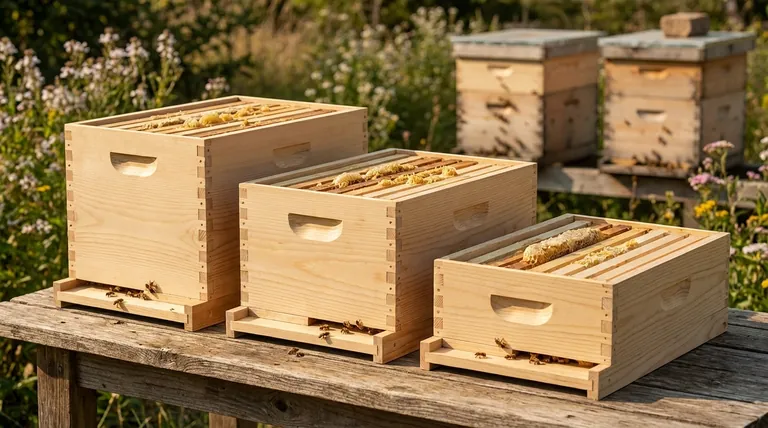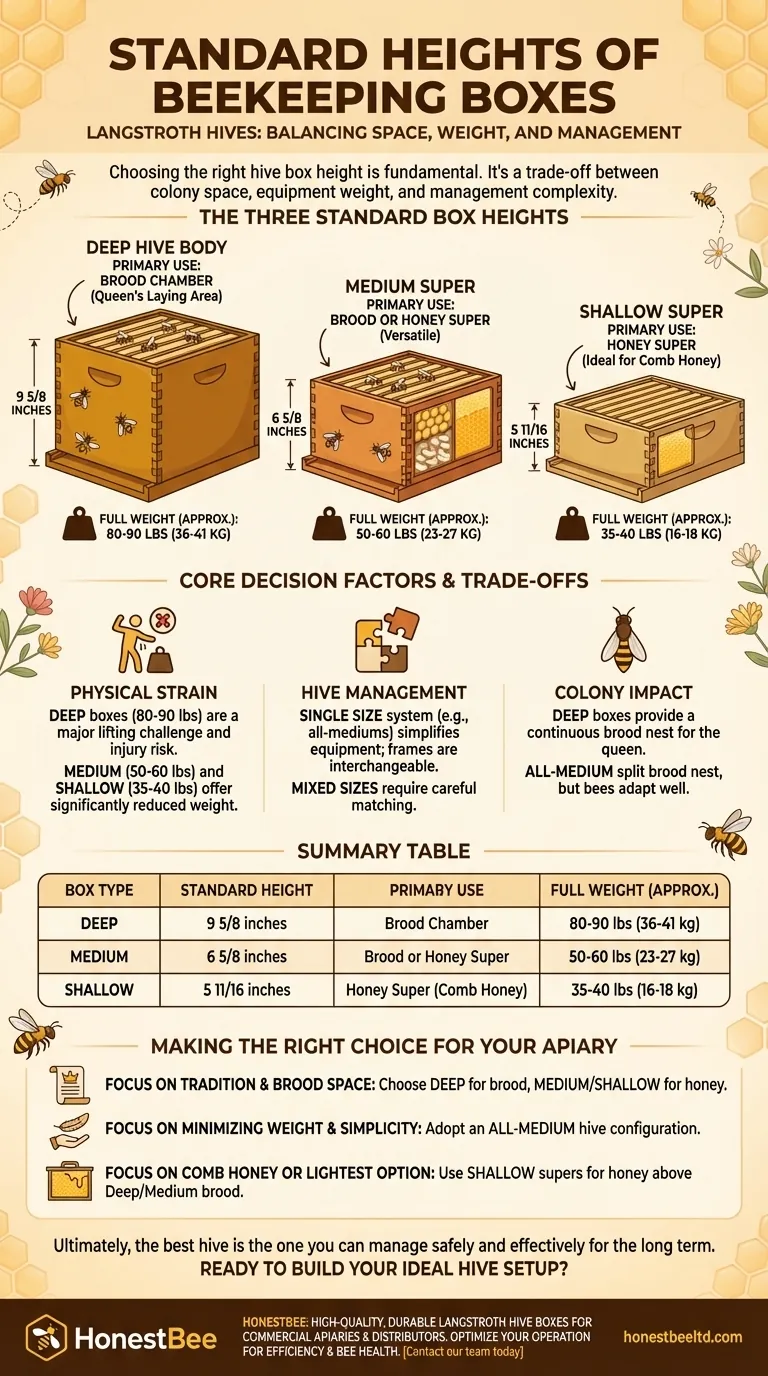In beekeeping, there are three standard box heights used for Langstroth hives. The Deep box is 9 5/8 inches tall, the Medium (or Illinois Super) is 6 5/8 inches, and the Shallow is 5 11/16 inches. These dimensions dictate the function of the box, its weight, and the management style you will employ.
Choosing a hive box height is one of the most fundamental decisions a beekeeper makes. It is a direct trade-off between providing the colony with ample, uninterrupted space and managing the physical weight and complexity of the equipment.

The Three Standard Beehive Box Heights
Each box size was designed with a specific purpose in mind, from housing the core of the colony to storing surplus honey. Understanding these roles is the first step in selecting your equipment.
Deep Hive Body (9 5/8 inches)
This is the traditional and largest standard box. Its primary role is to serve as the brood chamber, the area where the queen lays eggs and the colony raises new bees.
A single deep box provides a vast, continuous area for the queen's laying pattern, which many believe is beneficial for rapid colony expansion. Its significant volume also provides ample space for winter food stores.
Medium Super (6 5/8 inches)
The medium super is the most versatile of the three. It can be used as a honey super (a box for storing surplus honey) or, when stacked, as a brood chamber.
This versatility is its greatest strength. A beekeeper can choose to run an "all-medium" hive, where every box is the same size. This drastically simplifies equipment management, as all frames are interchangeable.
Shallow Super (5 11/16 inches)
The shallow super is the smallest and lightest box. It is used almost exclusively as a honey super.
Because of its reduced height, it's particularly well-suited for producing comb honey, where the entire frame of wax and honey is harvested. Its light weight also makes it a favored choice for beekeepers with physical limitations.
Why Box Height is a Beekeeper's Core Decision
Your choice is not just about a few inches of wood. It determines how you will interact with your hives for years to come, impacting everything from your physical health to your management efficiency.
Impact on Beekeeper's Physical Strain
This is arguably the most critical factor. A deep box filled with honey, brood, and pollen can weigh 80 to 90 pounds (36-41 kg). Lifting this is a significant physical challenge and a common source of back injury.
A filled medium super weighs a more manageable 50 to 60 pounds (23-27 kg), while a shallow super is the lightest at 35 to 40 pounds (16-18 kg). This difference is the primary reason many beekeepers move away from using deep boxes.
Impact on Hive Management
Using a single box size—typically all mediums—creates an incredibly flexible and efficient system. You never have to worry if a frame will fit in a given box.
This interchangeability allows for simple management techniques. You can easily move frames of brood or honey between boxes to strengthen weak colonies, encourage expansion, or prevent swarming.
Impact on the Bee Colony
A double-deep brood chamber offers the queen a massive, vertically continuous area to lay, closely mimicking the space found in a natural tree hollow.
In an all-medium setup, the brood nest is split between two or more boxes. While a physical gap exists, the bees readily cross it, and the queen adapts her laying pattern. A well-managed colony will thrive in either configuration.
Understanding the Trade-offs
There is no single "best" system. Each approach has distinct advantages and disadvantages that you must weigh against your personal goals and physical capabilities.
The "Traditional" Deep Brood Box
The primary advantage is the large, uninterrupted brood nest in a single box. This is simple to conceptualize and requires fewer frames and boxes to achieve the necessary volume for the colony.
The overwhelming disadvantage is the extreme weight. A hive inspection that requires lifting a full deep box off the hive is a serious physical task that becomes more difficult with age or injury.
The "All-Medium" Versatility
The key benefit is weight reduction and interchangeability. Every piece of equipment works with every other piece, simplifying your inventory and your hive-side decision-making.
The trade-off is that you need more equipment to achieve the same volume. Two medium boxes are roughly equivalent to one deep box plus one shallow super, meaning more frames to inspect and more boxes to manipulate.
The Niche Role of Shallows
Shallows are excellent for their specific purpose: producing light, easy-to-handle honey supers or pristine comb honey.
However, their small size makes them inefficient for a brood chamber or for large-scale honey production, as you would need many boxes and frames to provide adequate space.
Making the Right Choice for Your Apiary
Select the system that fits your physical abilities and management philosophy. The bees will adapt; the most important factor is a system that allows you to be a consistent and effective beekeeper.
- If your primary focus is tradition and maximizing brood space in a single box: Choose deep hive bodies for your brood chamber and medium or shallow supers for honey.
- If your primary focus is minimizing weight and simplifying equipment: Adopt an all-medium hive configuration for both brood and honey.
- If your primary focus is producing comb honey or you need the lightest possible option: Use shallow supers for your honey collection above a deep or medium brood chamber.
Ultimately, the best hive is the one you can manage safely and effectively for the long term.
Summary Table:
| Box Type | Standard Height | Primary Use | Full Weight (Approx.) |
|---|---|---|---|
| Deep | 9 5/8 inches | Brood Chamber | 80-90 lbs (36-41 kg) |
| Medium | 6 5/8 inches | Brood or Honey Super | 50-60 lbs (23-27 kg) |
| Shallow | 5 11/16 inches | Honey Super (Ideal for Comb Honey) | 35-40 lbs (16-18 kg) |
Ready to build your ideal hive setup? HONESTBEE supplies commercial apiaries and beekeeping equipment distributors with high-quality, durable Langstroth hive boxes and components through our wholesale-focused operations. Let us help you optimize your operation with the right equipment for efficiency and bee health. Contact our team today to discuss your needs and request a quote!
Visual Guide

Related Products
- Langstroth Honey Bee Box Hive Boxes for Different Depths
- Australian Langstroth Beehive Boxes for Beekeeping Wholesales
- HONESTBEE Professional Long Handled Hive Tool with Precision Cutting Blade
- Langstroth Bee Hives Bee Keeping Box for Beginners Beekeeping
- Long Langstroth Style Horizontal Top Bar Hive for Wholesale
People Also Ask
- How is checking honey supers in a Langstroth hive different from inspecting Honey Flow supers? A Guide to Disruptive vs. Non-Invasive Methods
- What are the sizes available for Langstroth boxes? A Guide to 8-Frame vs. 10-Frame & Depths
- How does a hive box work? A Guide to the Langstroth Hive System for Beekeepers
- What are the sizes of supers available in a standard hive? A Guide to Deep, Medium, and Shallow Boxes
- How deep is a medium bee box? Unlock the Key to a Versatile and Manageable Hive



















